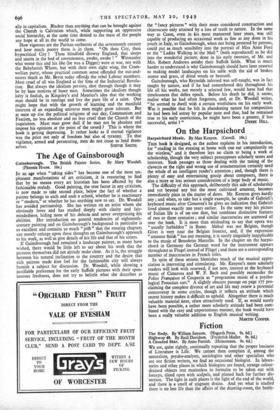The Age of Gainsborough
Gainsborough. The British Painter Series. By Mary Woodall. (Phoenix House. 16s.) IN an age when "taking sides" has become one of the most un- pleasant manifestations of art criticism, it is reassuring to find that by no means every art historian has been affected by the fashionable malady. Good painting, the true factor in any criticism, is now made to take second place, below the fact of whether a painter belongs to such and such a school, whether he is reactionary or "modern," or whether he has anything new to say. Dr. Woodall has avoided partisanship. She has written on an artist whom she obviously loves and has studied deeply with clarity and fair- mindedness, hiding none of his defects and never overpraising his abilities. Her introduction on general tendencies of eighteenth- century painting and on Gainsborough's background in particular is so excellent and contains so much " pith " that the ensuing chapters can merely enlarge upon these thoughts on Gainsborough's approach to his work, as well as give details of his life and that of his sitters. If Gainsborough had remained a landscape painter, as many have wished, there would be little left to say about his work that the pictures themselves did not already make clear. As it is, the struggle between his natural inclination to the country and the desire that rich patrons made him feel for the fashionable city will always furnish a subject for discussion. Dr. Woodall, while showing a justifiable preference for the early Suffolk pictures with their spon- taneous freshness, does not try to belittle what she describes as
the "fancy pictures" with their more considered construction and chiaroscuro only attained by a loss of truth to nature. In the same way as Corot, even in his most mannered later years, was stilt capable of producing an occasional work as fine as any done in his youth in Italy, so Gainsborough, when not being pestered by patrons, could put as much sensibility into the portrait of Miss Anne Ford or the "Ladies Walking in the Mall" (both reproduced) as he did into the wonderful picture, done in his early twenties, of Mr. and Mrs. Robert Andrews amidst their Suffolk fields. What is much harder to understand is why Gainsborough should have later resorted to making model landscapes on his table with the aid of broken stones and grass, of dried weeds or broccoli.
Gainsborough, who Reynolds inferred was self-taught, was in fact taught by nature, and if he had remembered this throughout his life all his works, not merely a selected few, would have had that timelessness that defies epoch. Before his death he did, it seems, realise what he had often forgotten, and, as Dr. Woodall writes, "he seemed to dwell with a certain wistfulness on his early work. Was it possible that he felt in abandoning nature for composition he had been led astray by popular taste and that, had he remained true to his early convictions, he might have been a greater, if less










































 Previous page
Previous page